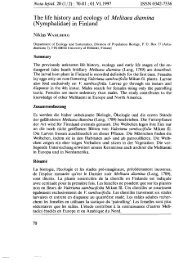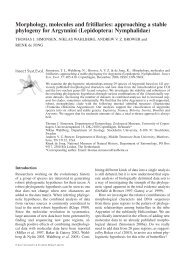Phylogenetic relationships of butterflies of the tribe Acraeini ...
Phylogenetic relationships of butterflies of the tribe Acraeini ...
Phylogenetic relationships of butterflies of the tribe Acraeini ...
You also want an ePaper? Increase the reach of your titles
YUMPU automatically turns print PDFs into web optimized ePapers that Google loves.
530 K.L. Silva-Brandão et al. / Molecular <strong>Phylogenetic</strong>s and Evolution 46 (2008) 515–531(Japan), Rudi Mattoni (USA-Argentina), Renato RognerRamos, Eduardo Emery, Elaine Cambui Barbosa (Brazil),Roger Vila, and Andrew Brower (USA). The authors areespecially grateful to <strong>the</strong> African Butterfly Research Instituteand to Dr. Jacques Pierre (Museum National d’HistoireNaturelle, France) for providing specimens fromAfrica. Andean species were identified by Dr. Gerardo Lamas(Peru) and Brazilian species were identified by Dr. RonaldoFrancini, Dr. Márlon Paluch, and Dr. André V. L.Freitas. The authors thank Rosângela A. Rodrigues fortechnical assistance, and Dr. José R. Trigo, Dr. JacquesPierre, and two anonymous referrers for discussions andcomments on <strong>the</strong> manuscript. This research was supportedby <strong>the</strong> Brazilian CNPq (fellowship 151004/2005-6) and byFundacßão de Amparo à Pesquisa—FAPESP (Grants #06/60127-0 and #07/53919-0) to K.L.S.B., and by FAPESPto A.M.L.A.E. (Grant 05/57680-7). D.C.L. was supportedby Leverhulme Trust Research Fellowship #F/00696/I(2002). N.W. was supported by a grant from <strong>the</strong> SwedishResearch Council and <strong>the</strong> Academy <strong>of</strong> Finland. A.V.L.F.thanks FAPESP (Grants 00/01484-1 and 04/05269-9 and<strong>the</strong> BIOTA-FAPESP program—98/05101-8), <strong>the</strong> BrazilianCNPq (fellowship 300315/2005-8) and <strong>the</strong> National ScienceFoundation Grant DEB-0527441.ReferencesAckery, P.R., 1988. Hostplants and classification—a review <strong>of</strong> nymphalid<strong>butterflies</strong>. Biol. J. Linn. Soc. 33, 95–203.Ackery, P.R., Smith, C.R., Vane-Wright, R.I., 1999. Carcasson’s AfricanButterflies: An Annotated Catalogue <strong>of</strong> <strong>the</strong> Papilionoidea and Hesperioidea<strong>of</strong> <strong>the</strong> Afrotropical Region. CSIRO Publishing, Australia.Baker, R.H., DeSalle, R., 1997. Multiple sources <strong>of</strong> character informationand <strong>the</strong> phylogeny <strong>of</strong> Hawaiian drosophilids. Syst. Biol. 46, 654–673.Baker, R.H., Yu, X.B., DeSalle, R., 1998. Assessing <strong>the</strong> relativecontribution <strong>of</strong> molecular and morphological characters in simultaneousanalysis trees. Mol. Phylogenet. Evol. 9, 427–436.Bremer, K., 1988. The limits <strong>of</strong> amino-acid sequence data in angiospermphylogenetic reconstruction. Evolution 42, 795–803.Bremer, K., 1994. Branch support and tree stability. Cladistics 10, 295–304.Brower, A.V.Z., 2000. <strong>Phylogenetic</strong> <strong>relationships</strong> among <strong>the</strong> Nymphalidae(Lepidoptera) inferred from partial sequences <strong>of</strong> <strong>the</strong> wingless gene.Proc. R. Soc. Lond. B Biol. 267, 1201–1211.Brower, A.V.Z., DeSalle, R., 1998. Patterns <strong>of</strong> mitochondrial versusnuclear DNA sequence divergence among nymphalid <strong>butterflies</strong>: <strong>the</strong>utility <strong>of</strong> wingless as a source <strong>of</strong> characters for phylogenetic inference.Insect Mol. Biol. 7, 73–82.Brown, K.S., 1992. Borboletas da Serra do Japi: diversidade, habitats,recursos alimentares e variacßão temporal. In: Morellato, L.P.C.O.(Ed.), História natural da Serra do Japi. Unicamp, Fapesp, Campinas,SP, pp. 142–187.Brown, K.S., Francini, R.B., 1990. Evolutionary strategies <strong>of</strong> chemicaldefense in aposematic <strong>butterflies</strong>: cyanogenesis in Asteraceae-feedingAmerican Acraeinae. Chemoecology 1, 52–56.Caterino, M.S., Sperling, F.A.H., 1999. Papilio phylogeny based onmitochondrial cytochrome oxidase I and II genes. Mol. Phylogenet.Evol. 11, 122–137.Cho, S.W., Mitchell, A., Regier, J.C., Mitter, C., Poole, R.W., Friedlander,T.P., Zhao, S.W., 1995. A highly conserved nuclear gene forlow-level phylogenetics—Elongation factor-1-alpha recovers morphology-basedtree for Heliothine moths. Mol. Biol. Evol. 12, 650–656.DeVries, P.J., 1987. The Butterflies <strong>of</strong> Costa Rica and <strong>the</strong>ir NaturalHistory. Princeton University Press, New Jersey.DeVries, P.J., 2002. Differential wing toughness in distasteful andpalatable <strong>butterflies</strong>: direct evidence supports unpalatable <strong>the</strong>ory.Biotropica 34, 176–181.Faith, D.P., Cranston, P.S., 1991. Could a cladogram this short havearisen by chance alone—on permutation tests for cladistic structure.Cladistics 7, 1–28.Felsenstein, J., 1985. Confidence-limits on phylogenies—an approachusing <strong>the</strong> bootstrap. Evolution 39, 783–791.Ferreira, M.J.P., Brant, A.J.C., Rufino, A.R., Alvarenga, S.A.V., Magri,F.M.M., Emerenciano, V.P., 2004. Prediction <strong>of</strong> occurrences <strong>of</strong> diversechemical classes in <strong>the</strong> Asteraceae through artificial neural networks.Phytochem. Analy. 15, 389–396.Fontane, M., 1988. Lépidoptères du Zaïre et du Rwanda Burundi (Fam.Acraeidae). Lambillionea 88, 87–103.Francini, R.B., 1989. Biologia e ecologia das borboletas Actinote(Lepidoptera: Nymphalidae, Acraeinae) do sudeste do Brasil. Ms<strong>the</strong>sis. Universidade Estadual de Campinas, Campinas.Francini, R.B., 1992. Ecologia das taxocenoses de Actinote (Lepidoptera:Nymphalidae) em Asteraceae (Angiosperma, Magnoliatae) no sudestedo Brasil: subsídios para conservacßão. Ph.D. <strong>the</strong>sis. Unicamp,Campinas.Francini, R.B., Freitas, A.V.L., Brown, K.S., 2005. Rediscovery <strong>of</strong>Actinote zikani (D’Almeida) (Nymphalidae, Heliconiinae, <strong>Acraeini</strong>):natural history, population biology and conservation <strong>of</strong> an endangeredbutterfly in SE Brazil. J. Lepidop. Soc. 59, 134–142.Francini, R.B., Freitas, A.V.L., Penz, C., 2004. Two new species <strong>of</strong>Actinote (Lepidoptera, Nymphalidae) from Sou<strong>the</strong>astern Brazil. Zootaxa719, 1–10.Freeland, J.R., 2006. Molecular Ecology. John Wiley & Sons Ltd., WestSussex, England.Freitas, A.V.L., 1999. Nymphalidae (Lepidoptera), filogenia com base emcaracteres de imaturos, com experimentos de troca de plantashospedeiras. Ph.D. <strong>the</strong>sis. Universidade Estadual de Campinas,Campinas.Freitas, A.V.L., Brown, K.S., 2004. Phylogeny <strong>of</strong> <strong>the</strong> Nymphalidae(Lepidoptera). Syst. Biol. 53, 363–383.Golob<strong>of</strong>f, F., Farris, J.S., Nixon, K.C., 2003. TNT: Tree Analysis usingNew Technology. Program and documentation, available from <strong>the</strong>authors.Golob<strong>of</strong>f, P.A., 1999. Analysing large data sets in reasonable times:solutions for composite optima. Cladistics 15, 415–428.Hall, T.A., 1999. BioEdit: a user-friendly biological sequence alignmenteditor and analysis program for Windows 95/98/NT. Nucleic AcidsSymp. Ser. 41, 95–98.Harvey, D., 1991. Appendix B: Higher classification <strong>of</strong> <strong>the</strong> Nymphalidae.In: Nijhout, H.F. (Ed.), The Development and Evolution <strong>of</strong> ButterflyWing Patterns. Smithsonian Institution Press, Washington, pp. 255–273.Huelsenbeck, J.P., Larget, B., Miller, R.E., Ronquist, F., 2002. Potentialapplications and pitfalls <strong>of</strong> Bayesian inference <strong>of</strong> phylogeny. Syst. Biol.51, 673–688.Huelsenbeck, J.P., Ronquist, F., 2001. MRBAYES: Bayesian inference <strong>of</strong>phylogenetic trees. Bioinformatics 17, 754–755.Huelsenbeck, J.P., Ronquist, F., Nielsen, R., Bollback, J.P., 2001.Bayesian inference <strong>of</strong> phylogeny and its impact on evolutionarybiology. Science 294, 2310–2314.Janz, N., Nylin, S., Wahlberg, N., 2006. Diversity begets diversity: hostexpansions and <strong>the</strong> diversification <strong>of</strong> plant-feeding insects. Bmc Evol.Biol. 6, 4.Kassarov, L., 2001. Do cyanogenic glycosides and pyrrolizidine alkaloidsprovide some <strong>butterflies</strong> with a chemical defense against <strong>the</strong>ir birdpredators? A different point <strong>of</strong> view. Behaviour 138, 45–67.Lamas, G., 2004. Checklist: Part 4A. Hesperioidea–Papilionoidea. In:Heppner, J.B. (Ed.), Atlas <strong>of</strong> Neotropical Lepidoptera, vol. 5A.Association for Tropical Lepidoptera/Scientific Publishers, Gainesville,p. xxxvi + 439 pp.





